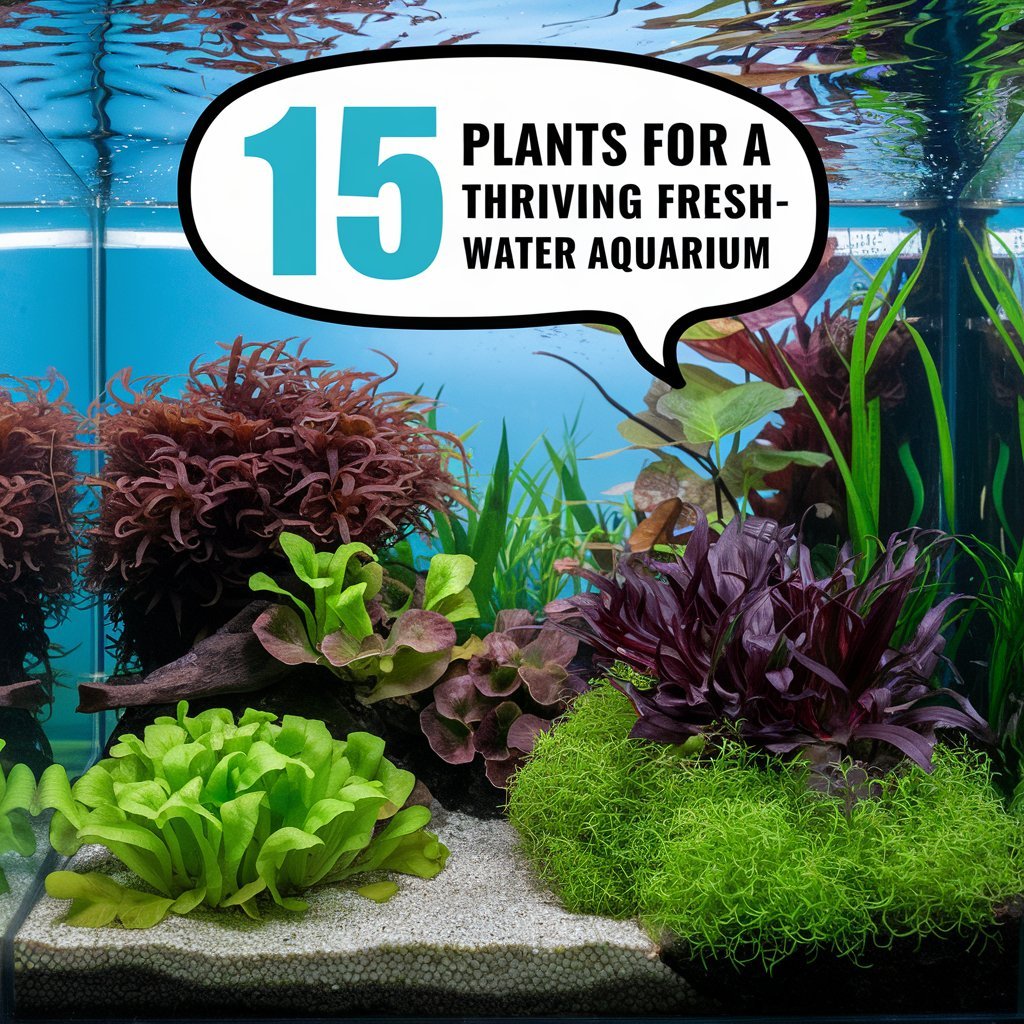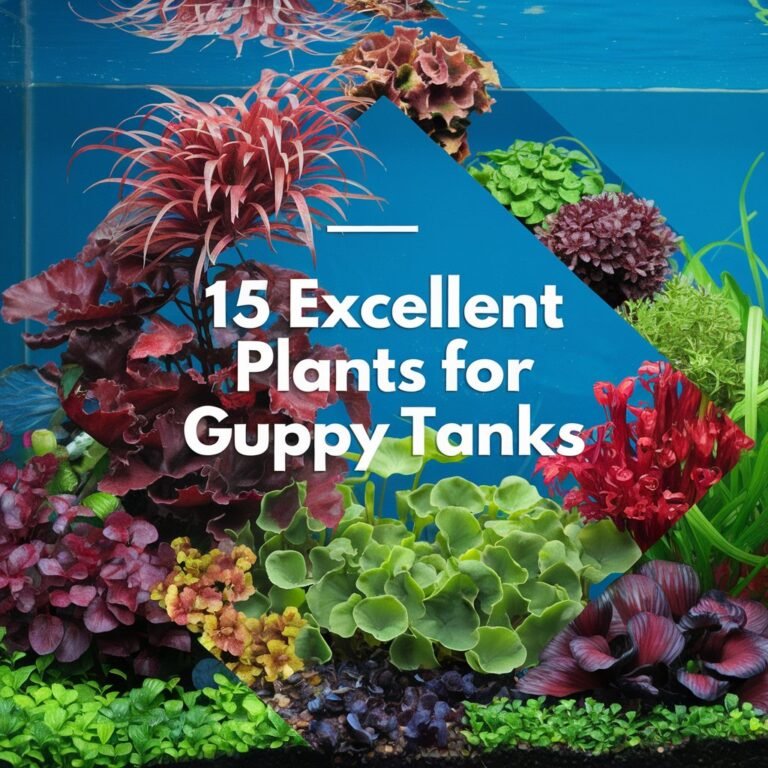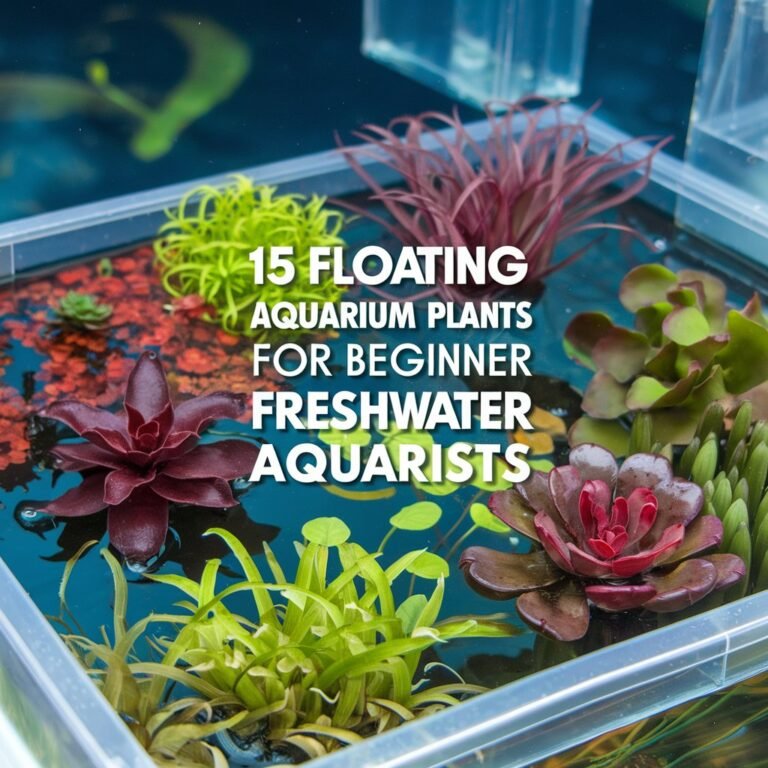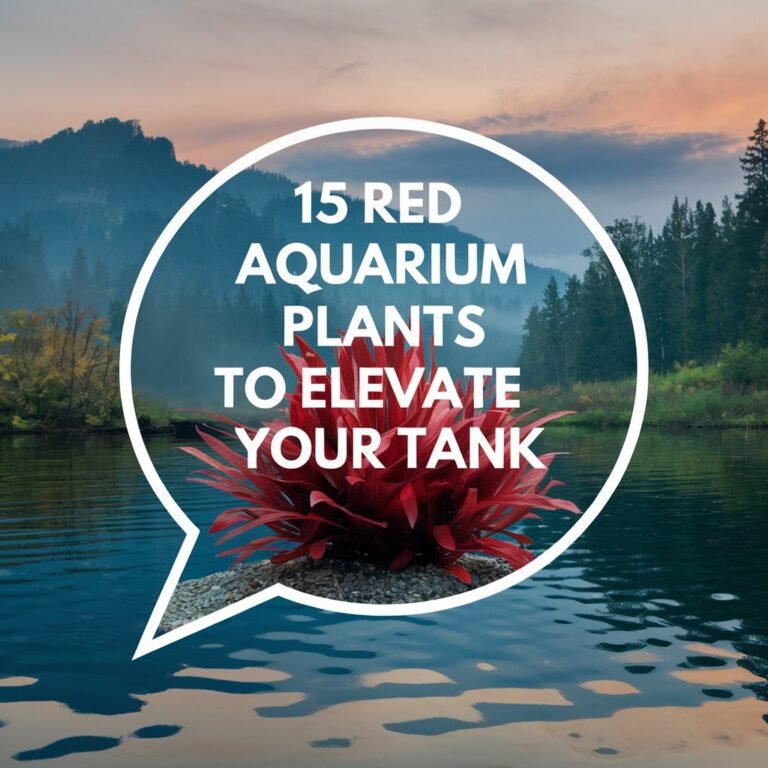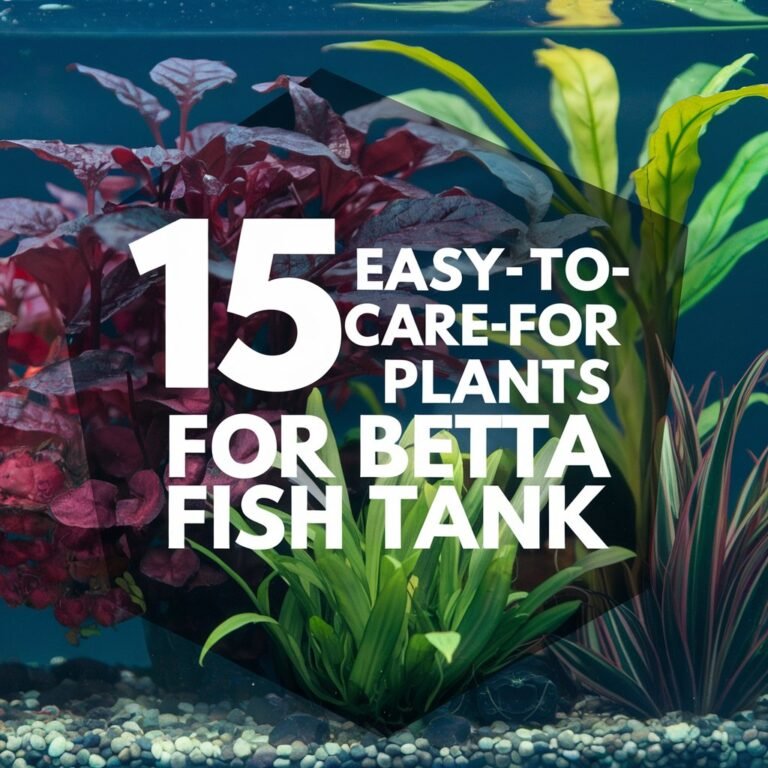15 Plants for a Thriving Freshwater Aquarium
You’re looking to create a thriving freshwater aquarium in 2024, but you’re not sure where to start with plant selection. Choosing the right plants can make all the difference in creating a balanced ecosystem and a visually stunning environment.
With so many options available, it can be overwhelming to decide which plants will work best for your aquarium. From low-maintenance species to those that require more attention, there are 15 plants that stand out as top choices for a thriving freshwater aquarium. But which ones will thrive in your unique setup?
In A Nutshell
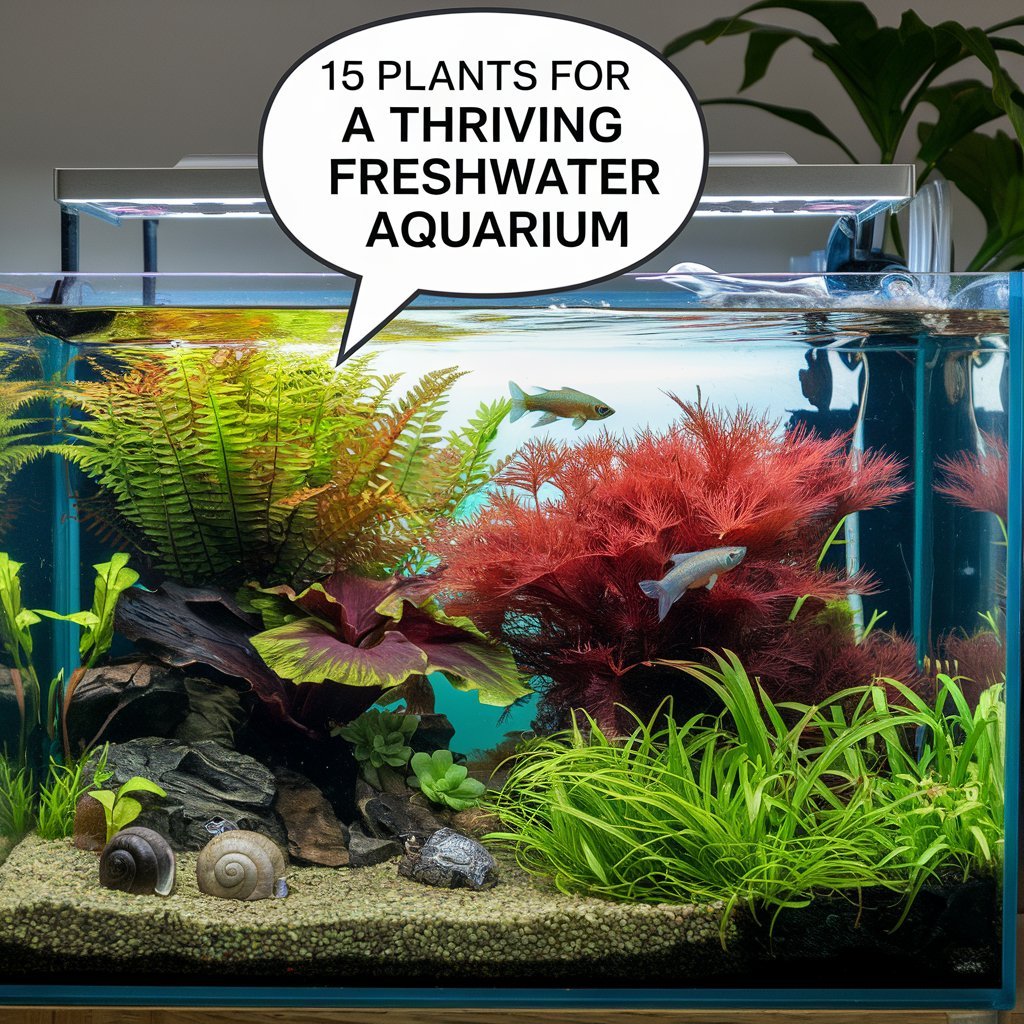
- Choose plants with similar lighting requirements, such as Amazon Swords and Water Wisteria, for a thriving freshwater aquarium.
- Select plants with adaptable temperature requirements, like Java Moss and Hornwort Plant, for a stable aquarium environment.
- Consider plants with a wide pH tolerance, such as Java Moss and Pogostemon Stellatus, for a low-maintenance aquarium.
- Balance plant selection with varying water hardness requirements, like Cabomba Piauhyensis and Dwarf Hairgrass, for a diverse aquarium.
- Regular pruning, fertilization, and water changes are essential for the care and maintenance of a thriving freshwater aquarium.
Amazon Swords
The freshwater enthusiast’s staple, Amazon Swords are one of the most recognizable and popular plants in aquariums, providing vibrant color and unique texture.
You’ve likely seen them in many aquascapes, and for good reason. With proper care, Amazon Swords can thrive in your aquarium, creating a stunning display of green and red hues.
When it comes to Amazon care tips, you’ll want to focus on providing your plants with bright, indirect light and temperatures between 72-82°F (22-28°C).
Water hardness should be between 5-20 dGH, and pH levels should range from 6.5-7.5. Regular water changes and a balanced fertilizer will also promote healthy growth.
There are several Amazon sword varieties to choose from, each with its own unique characteristics.
Echinocorys amazonicus, or the Amazon Sword, is one of the most popular varieties, known for its long, slender leaves.
Echinocorys ozeloti, or the Ozelot Sword, features shorter, more rounded leaves.
Java Moss
You’ll often find Java Moss utilized as a versatile, low-maintenance addition to freshwater aquariums, thanks to its ability to thrive in a variety of environments.
This plant can grow in different lighting conditions, from low to high, and can tolerate pH levels between 5.0 and 8.0.
Java Moss is also known for its ability to attach itself to surfaces, making it an ideal choice for creating moss carpeting, a popular technique in Java aquascaping.
To successfully grow Java Moss, you’ll want to guarantee it’s attached to a surface, such as a rock or driftwood.
It can be tied to the surface using a fishing line or thread.
Java Moss also requires regular maintenance, such as trimming to prevent it from growing too dense and reducing light penetration.
It’s also essential to maintain good water circulation to prevent algae buildup.
Java Moss is a great choice for creating a natural environment in your aquarium and can be used to create stunning aquascapes with rocks and driftwood.
With proper care, Java Moss can thrive in your freshwater aquarium.
Anubias Barteri
Anubias Barteri is a popular choice for freshwater aquariums due to its attractive, heart-shaped leaves and relatively low maintenance requirements. This aquatic plant contributes substantially to aquatic aesthetics by providing an excellent display of varying shapes, textures, and shades.
By anchoring its roots onto driftwood, rocks, or any substrate with proper placement, Anubias Barteri makes it simple to set up.
The best location to grow Anubias Barteri in the tank would be areas where strong currents or extreme light intensity may stress or disrupt it, placing the roots partially embedded while making sure to protect its roots system as roots get sensitive during these exchanges.
Typically the rhizome tends to find these sections allowing free distribution growth providing quality vision appeal since newly-sprouting off-set provides renewed photosynthetic adaptation creating true growing pattern all your new found new decorative beautiful setup!
Water Wisteria
Setting up a thriving Water Wisteria in your freshwater aquarium involves understanding its versatile growth patterns and accommodating its unique requirements.
This plant can be trained to grow as a mid-ground shrub or as a background vine, making it a great choice for aquascapers. Water wisteria care requires moderate to high lighting, with a minimum of 2-3 watts per gallon of T5 or T8 lighting.
It also prefers temperatures between 72-82°F (22-28°C) and pH levels between 6.5-7.5.
Water wisteria propagation is relatively easy and can be done through stem cuttings or by separating the plant’s rhizome.
To propagate through stem cuttings, simply cut a section of the stem, remove lower leaves, and plant it in the substrate. Keep the water parameters stable and provide adequate lighting for the new plant to grow.
Water wisteria care also involves regular pruning to maintain its desired shape and promote healthy growth.
Cryptocorynes
Growing a lush carpet of Cryptocorynes in your freshwater aquarium requires a solid understanding of their unique characteristics and specific needs.
Cryptocorynes are a diverse group of plants, with over 100 species varieties, each with its own distinct appearance and growth habits.
To succeed with Cryptocoryne care, you’ll need to provide them with a nutrient-rich substrate, moderate to high lighting, and stable water parameters.
Cryptocoryne care tips include maintaining a temperature range of 72-82°F (22-28°C) and pH levels between 6.5-7.5.
Regular water changes and a balanced fertilizer regimen are also vital for promoting healthy growth.
Some Cryptocoryne species, such as Cryptocoryne wendtii and Cryptocoryne parva, are more tolerant of varying water conditions and can thrive in a wider range of aquarium environments.
When selecting Cryptocoryne species varieties for your aquarium, consider factors such as plant size, leaf shape, and color.
Some popular varieties, like Cryptocoryne beckettii and Cryptocoryne nurii, offer striking foliage and can add visual interest to your aquarium.
Dwarf Hairgrass
A lush aquatic lawn, dominated by the carpeting ability of Dwarf Hairgrass (Eleocharis parvula), is within your reach by meeting this versatile, adaptable plant’s key needs.
As an aquatic landscaper, you’ll appreciate the ability of Dwarf Hairgrass to create a grassland ecosystem in your tank, with its delicate, fine leaves that sway gently in the water current.
To thrive, Dwarf Hairgrass requires moderate to high lighting, with a minimum of 1.5 watts per gallon, and a temperature range of 68-82°F (20-28°C).
In terms of water parameters, Dwarf Hairgrass prefers slightly acidic to neutral water, with a pH range of 6.0-7.5, and moderate water hardness.
Regular fertilization, especially with micronutrients, is essential to promote healthy growth and prevent deficiencies.
With proper care, Dwarf Hairgrass can form a dense, lush carpet, making it an ideal choice for creating a natural, grassy landscape in your aquarium.
By replicating the conditions found in its natural habitat, you can successfully cultivate Dwarf Hairgrass and enjoy the beauty of a thriving aquatic lawn.
Regular pruning and maintenance will help maintain its shape and promote healthy growth.
Cabomba Piauhyensis
Precision in replicating the natural environment is key to tapping the full potential of Cabomba Piauhyensis, a versatile and relatively rare plant species in the aquarium hobby.
You’ll need to provide it with soft, slightly acidic water, with a pH range of 6.0-7.0 and a temperature between 72°F and 82°F.
Cabomba care tips emphasize the importance of moderate to high lighting, as this plant thrives in conditions that mimic its natural habitat.
To bring out the best in Cabomba Piauhyensis, you should also maintain a moderate water flow and guarantee that the plant receives essential nutrients through regular fertilization.
Piauhyensis benefits from a balanced diet that includes nitrogen, phosphorus, and potassium.
By providing the right conditions, you can enjoy the plant’s delicate, lacy foliage and vibrant green color.
Regular pruning is also vital to maintain the plant’s shape and promote healthy growth.
By following these Cabomba care tips, you can release the full potential of this stunning plant and create a thriving freshwater aquarium.
With proper care, Cabomba Piauhyensis can be a beautiful addition to your aquatic landscape.
Water Sprite
While replicating the natural environment of Cabomba Piauhyensis requires specific conditions, you’ll find that Water Sprite is more adaptable and forgiving.
This plant, scientifically known as Ceratopteris thalictroides, is a popular choice for freshwater aquariums due to its ease of care. Water sprite care involves providing moderate to bright lighting, with a temperature range of 72-82°F (22-28°C) and pH levels between 6.5-7.5.
Water sprite propagation is relatively simple, as it can be done by separating the rhizome or by cutting off plantlets that have formed on the mother plant.
It’s crucial to trim the plant regularly to maintain its shape and promote healthy growth. You can also use the trimmings for water sprite propagation, making it an excellent choice for aquarium hobbyists who want to share plants with friends or propagate new plants.
When it comes to water sprite care, you should also verify that the plant has sufficient nutrients and CO2. A balanced fertilizer and a CO2 injection system can help promote healthy growth and prevent nutrient deficiencies.
With proper care, water sprite can thrive in a variety of aquarium environments, making it an excellent choice for both beginners and experienced aquarists.
Red Ludwigia
Harmony in a freshwater aquarium often hinges on selecting the right plants, and Red Ludwigia, scientifically known as Ludwigia repens, is an excellent choice for those seeking a versatile and vibrant option.
This plant’s adaptability and ability to thrive in various water conditions make it a popular choice among aquarists. You’ll notice Red Ludwigia exhibits stunning color variations, with hues ranging from deep red to orange and even green.
These colors can be influenced by factors such as lighting, nutrient availability, and CO2 levels.
When it comes to care, Red Ludwigia can be a bit more challenging than some other aquatic plants. It requires moderate to high lighting, with a minimum of 2 watts per gallon, and benefits from CO2 supplementation.
You should also maintain a temperature range of 72-82°F (22-28°C) and pH levels between 6.0-7.0. Additionally, regular pruning is necessary to promote healthy growth and prevent the plant from becoming leggy.
Green Hygrophila
When choosing aquatic plants for a thriving freshwater aquarium, Green Hygrophila is a top contender due to its adaptability, resilience, and stunning visual appeal.
You can successfully cultivate Green Hygrophila in a variety of lighting conditions, from low to high, making it an excellent choice for different aqua landscaping designs.
This plant’s ability to thrive in diverse environments allows you to create a beautiful, lush green backdrop for your aquarium.
To optimize the growth of Green Hygrophila, maintain a water temperature between 72°F and 82°F (22°C and 28°C) and pH levels between 6.5 and 7.5.
Provide regular water changes and fertilize the plant with a balanced, water-soluble fertilizer.
Green Hygrophila grows rapidly, and you should trim it regularly to maintain a desired shape and promote healthy growth.
Vallisneria Gigantea
What sets Vallisneria Gigantea apart from other freshwater aquarium plants is its ability to create a striking visual display through its slender, sword-like leaves that can grow up to 6 feet long.
This plant thrives in well-oxygenated waters and can tolerate a range of water parameters, making it a great choice for aquariums with diverse conditions.
As a Vallisneria species, Vallisneria Gigantea requires moderate to bright lighting and a temperature range of 72-82°F (22-28°C) to flourish.
When it comes to Vallisneria care tips, crucially, you must provide the plant with a substrate rich in nutrients and to trim its leaves regularly to maintain its shape and prevent overgrowth.
Vallisneria species variations, such as Vallisneria Americana and Vallisneria Nana, also exist, but Vallisneria Gigantea is one of the most popular due to its impressive growth and hardiness.
In terms of water flow, Vallisneria Gigantea prefers gentle currents, which can help prevent the leaves from becoming damaged or dislodged.
With proper care and attention, this plant can create a stunning underwater landscape in your freshwater aquarium, making it an excellent choice for experienced aquarists and beginners alike.
Pogostemon Stellatus
Several Pogostemon species are popular among aquarium enthusiasts, but Pogostemon Stellatus stands out for its unique, star-shaped leaves and versatility in different water conditions.
This plant thrives in a variety of lighting conditions, from low to high, making it suitable for different aquarium setups. When it comes to Stellatus care, you’ll want to maintain a temperature range of 72-82°F (22-28°C) and pH levels between 6.5-7.5.
Pogostemon Stellatus is a relatively low-maintenance plant that can tolerate some neglect. However, it will reward you with lush growth and vibrant colors if you provide it with regular fertilization and CO2 supplementation.
This plant can grow up to 12 inches (30 cm) in height, making it a great mid-ground or background plant.
One of the most striking features of Pogostemon Stellatus is its ability to produce star-shaped blooms. These flowers are relatively rare in aquarium plants, making Pogostemon Stellatus a unique addition to your aquatic garden.
With proper care and attention, you can encourage your Pogostemon Stellatus to produce these beautiful blooms, adding an extra layer of visual interest to your aquarium.
Hornwort Plant
You’ll find the Hornwort Plant, also known as Coontail or Ceratophyllum demersum, to be a versatile and low-maintenance addition to your freshwater aquarium.
It’s a free-floating plant that doesn’t require any special substrate or anchoring, making it an ideal choice for aquariums with unique layouts. Hornwort care is relatively straightforward, as it can thrive in a wide range of lighting conditions, from low to high, and can tolerate temperatures between 15°C to 30°C (59°F to 86°F).
Hornwort propagation is also a simple process.
You can propagate it by cutting off sections of the plant and allowing them to float freely in the aquarium. This method allows for rapid spread and encourages the plant to grow densely.
Hornwort can also be anchored to rocks or driftwood to create a more structured look. It’s a great choice for aquariums with small fish or shrimp, as it provides shelter and food for them.
Regular pruning is necessary to maintain the plant’s shape and promote healthy growth. By following these simple care and propagation steps, you can enjoy the benefits of having a thriving Hornwort Plant in your aquarium.
Rotala Rotundifolia
Beauty and versatility come together in Rotala Rotundifolia, a popular choice for freshwater aquariums.
This plant is known for its stunning red and pink hues, which you can achieve by providing it with high lighting and CO2.
To keep your Rotala thriving, follow these Rotala care tips: maintain water temperatures between 72-82°F (22-28°C) and pH levels between 6.5-7.5. Rotala Rotundifolia is a mid-to-background plant, so you’ll want to trim it regularly to maintain its shape and encourage bushy growth.
Rotala species variations include Rotala Macrandra, Rotala Wallichii, and Rotala H’ra, each with unique characteristics and growth habits.
You can plant Rotala Rotundifolia in groups or use it as a standalone feature in your aquarium.
When planting, guarantee the rhizome is above the substrate to prevent rot.
Rotala Rotundifolia is a moderate-to-fast growing plant, so be prepared to prune it regularly to maintain its desired shape.
With proper care and attention, Rotala Rotundifolia can add a stunning pop of color to your freshwater aquarium.
Bacopa Monnieri
While Rotala Rotundifolia thrives in high-lighting conditions, not all plants require such intense illumination.
You can achieve great results with Bacopa Monnieri, a low-maintenance, versatile aquatic plant that flourishes in moderate to low-light conditions. Native to North America, this herbaceous plant grows up to 12 inches in height, making it suitable for mid-ground placement in your aquarium.
Bacopa care tips include providing temperatures between 72°F and 82°F, pH levels between 6.0 and 8.0, and moderate water flow.
This plant is relatively easy to care for and can thrive in a variety of environments. When it comes to propagation, simply trim the stems and replant them in the substrate.
The Bacopa benefits aquariums in several ways. Its extensive root system helps to stabilize the substrate and prevent erosion.
Additionally, it provides a natural food source for fish and invertebrates, as well as a sheltered environment for them to hide and spawn.
With proper care, Bacopa Monnieri can become a lush, vibrant addition to your freshwater aquarium, providing numerous benefits for both the environment and its inhabitants.
Regular pruning will encourage bushy growth and prevent the plant from becoming leggy.
Frequently Asked Questions
What Is the Ideal Aquarium Size for Most Aquatic Plants?
You’re looking for an aquarium size that suits most aquatic plants; generally, a tank with a minimum water volume of 10 gallons is ideal, as it provides a stable aquatic environment for peak growth and health.
Can I Grow Plants in a Aquarium Without a Substrate Heater?
You can grow plants in a cold-water aquarium without a substrate heater, opting for low-light species like Java moss or Anubias, which thrive in temperatures between 15-20°C (59-68°F) and tolerate low light conditions.
How Often Should I Prune My Freshwater Aquarium Plants?
To maintain control over plant overgrowth, you’ll need to establish pruning schedules. Typically, you’ll prune your freshwater aquarium plants every 1-2 weeks, cutting back overgrown stems and removing dead or damaged leaves to promote healthy growth.
Are All Aquatic Plants Safe for Aquarium Fish to Eat?
When introducing aquatic plants to your aquarium, you should research fish preferences and plant toxicity first. Some plants, like certain algae, are toxic to fish, while others, like duckweed, are safe and even nutritious for them to eat.
Can I Use Tap Water for My Freshwater Aquarium Plants?
When filling your freshwater tank with tap water, test for chemicals, chlorine, and chloramines affecting water quality. Apply suitable water treatments or alternatives, as poor tap water chemistry may impact overall system performance negatively affecting the biome.
FInal Verdict
You’ve successfully selected the perfect plants for your thriving freshwater aquarium in 2024. By incorporating these 15 species, you’re creating a balanced ecosystem that caters to various lighting, temperature, pH, and water hardness requirements.
Regular trimming, balanced fertilization, and proper care will guarantee your plants thrive, providing a natural ambiance and unique benefits to your aquarium. Monitor and adjust conditions to meet the specific needs of each species for peak growth.
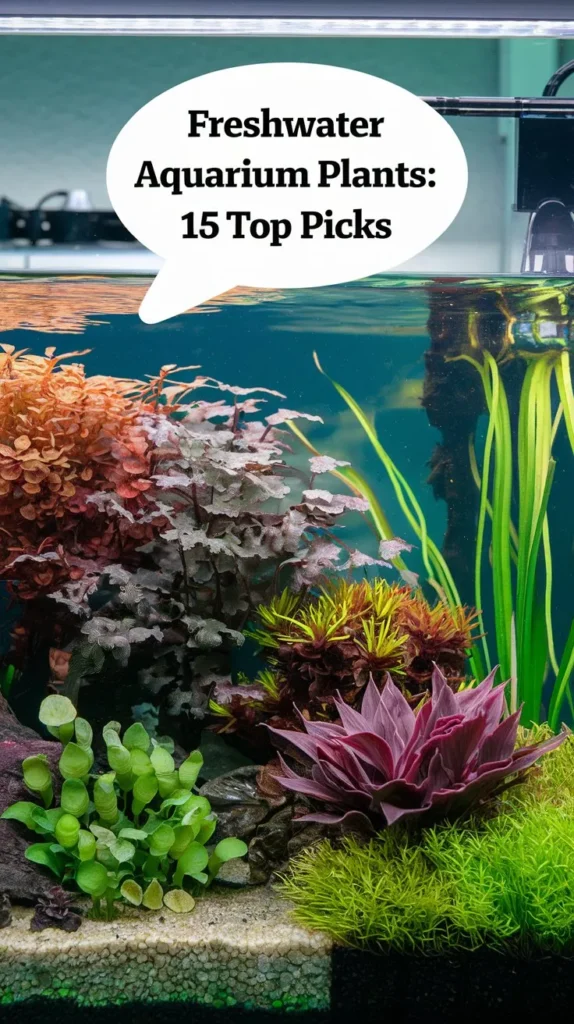
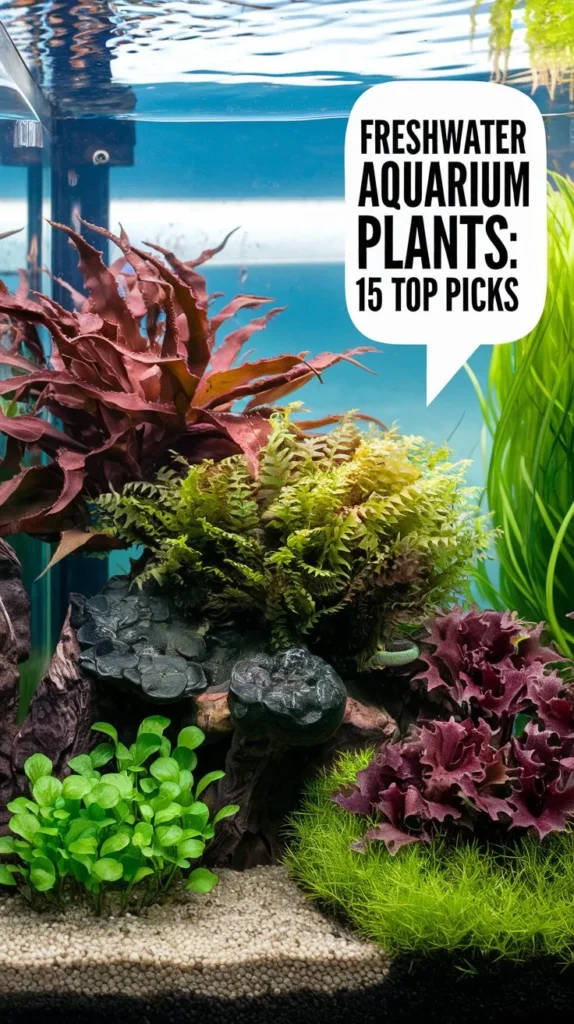
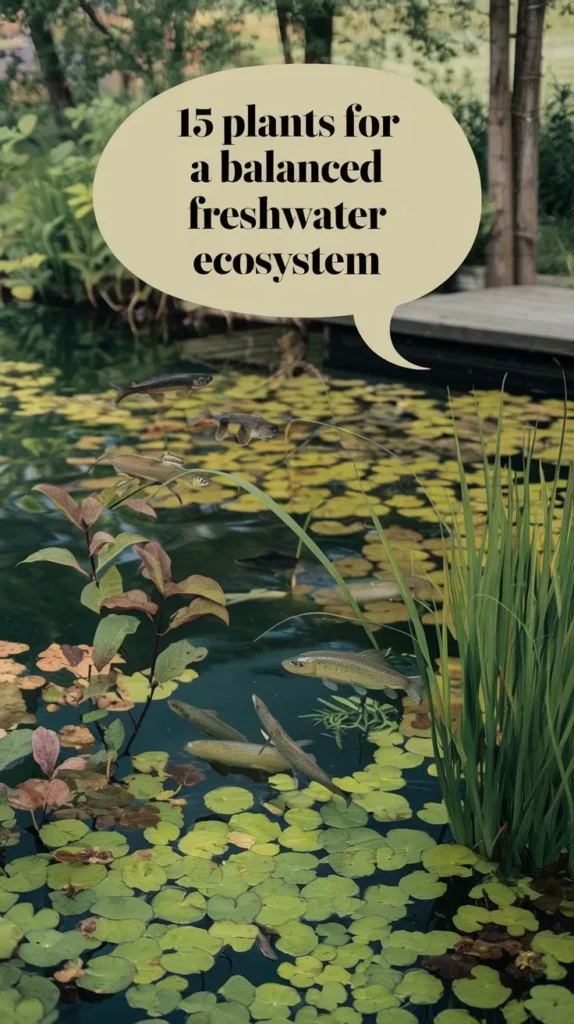
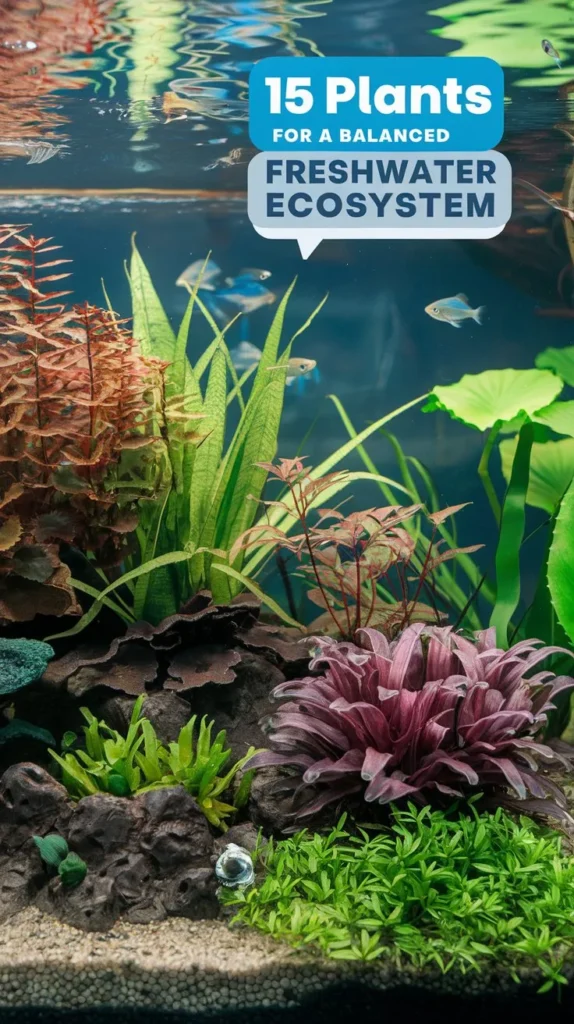
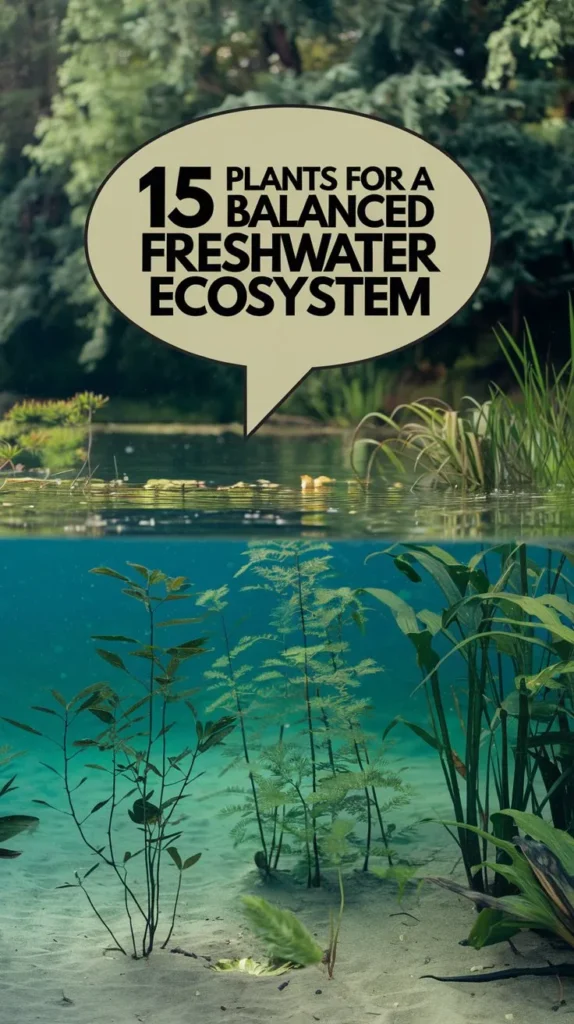

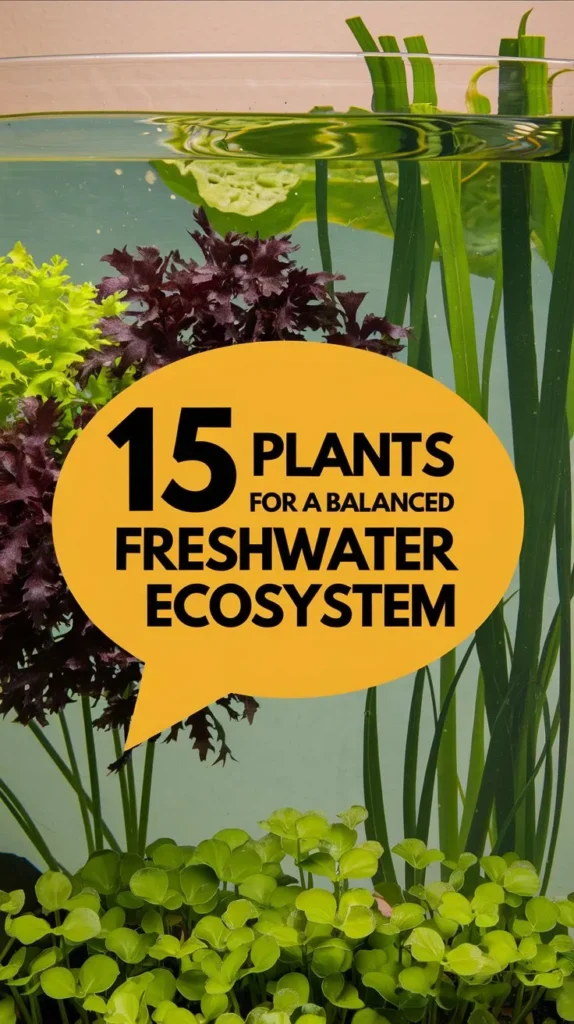
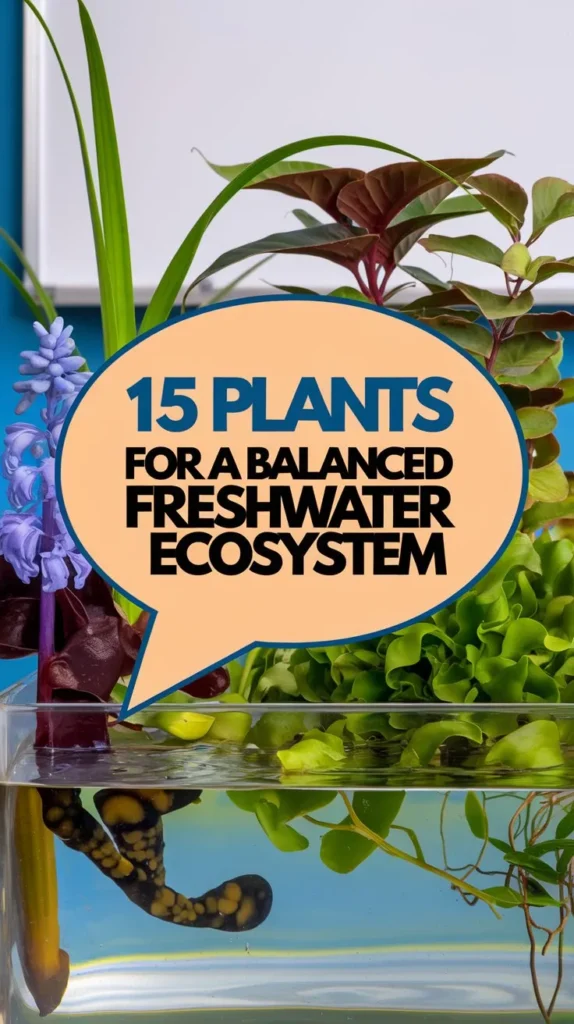
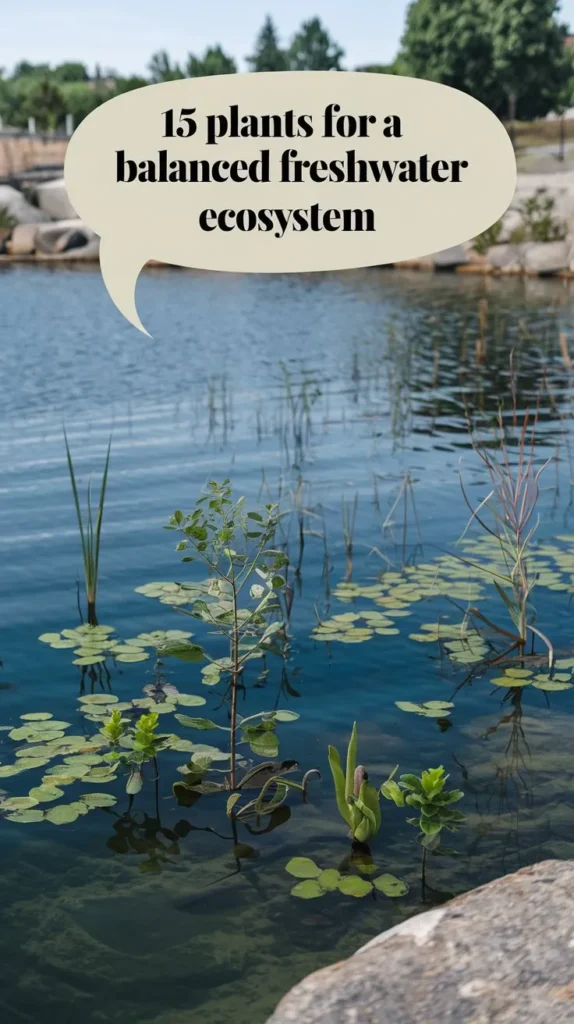
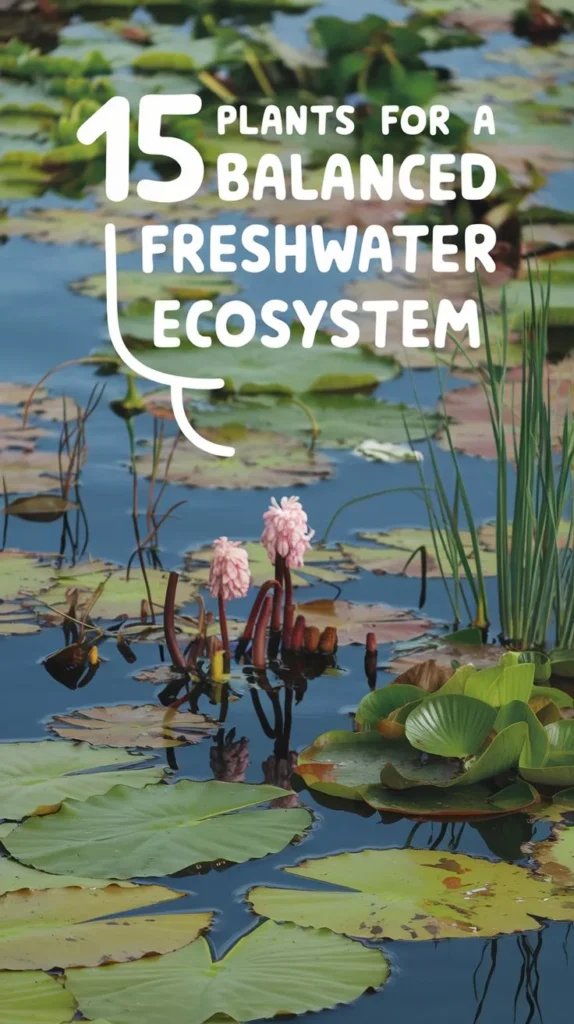

Hello, I’m Aria Cooper, the heart and soul behind Swimmy Buddies. As a devoted fish aficionado, I share my aquatic adventures and expertise to inspire your own underwater explorations. 🐠🌊

